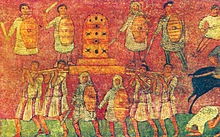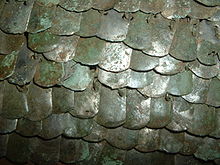Lorica Squamata

As lorica squamata (lat. Lorica = (belt) chilled, squama = Scale), the scale armor of the Roman cavalry in the Empire designated.
description
The Lorica Squamata consisted of iron or bronze metal plates in the form of fish scales , which were sewn onto a kind of shirt made of sturdy leather and connected on the long sides with wire. This was to prevent enemy weapons from piercing between the scales. The shape and size of the scales were variable. More than 30 different shapes have been found in Carnuntum , with the wearer's joints being protected by small, movable scales and the back and chest by larger ones. The tank weighed about 13 kg. In the 1st century the scale armor reached up to the middle of the thigh and was worn with a belt. It has a round neckline, epaulettes and short sleeves that, like the lower edge, are bordered by leather fringes. In the 2nd century, the short scale armor reaching to the hips became common. In the course of the 3rd century long, belted shed shirts appeared again, which reach knee height and have sleeves to the elbow. They were worn by horsemen and foot soldiers.
